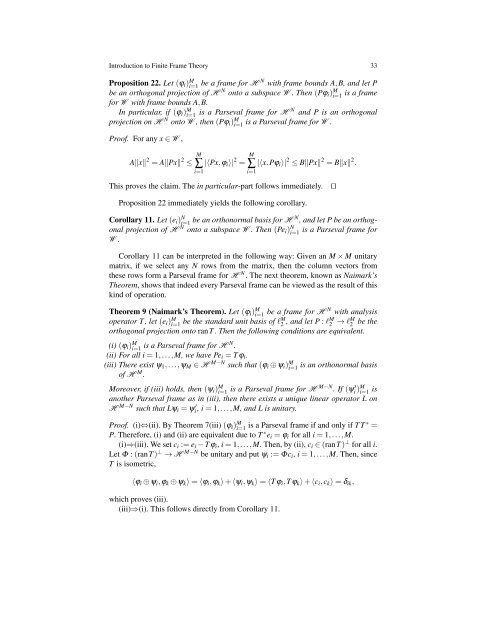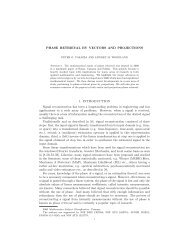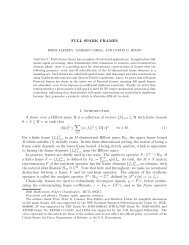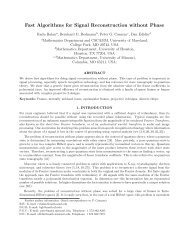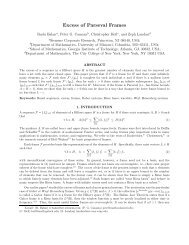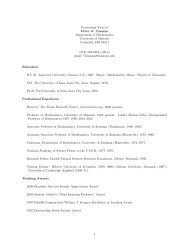Introduction to Finite Frame Theory - Frame Research Center
Introduction to Finite Frame Theory - Frame Research Center
Introduction to Finite Frame Theory - Frame Research Center
Create successful ePaper yourself
Turn your PDF publications into a flip-book with our unique Google optimized e-Paper software.
<strong>Introduction</strong> <strong>to</strong> <strong>Finite</strong> <strong>Frame</strong> <strong>Theory</strong> 33<br />
Proposition 22. Let (ϕ i ) M i=1 be a frame for H N with frame bounds A,B, and let P<br />
be an orthogonal projection of H N on<strong>to</strong> a subspace W . Then (Pϕ i ) M i=1 is a frame<br />
for W with frame bounds A,B.<br />
In particular, if (ϕ i ) M i=1 is a Parseval frame for H N and P is an orthogonal<br />
projection on H N on<strong>to</strong> W , then (Pϕ i ) M i=1 is a Parseval frame for W .<br />
Proof. For any x ∈ W ,<br />
A‖x‖ 2 = A‖Px‖ 2 ≤<br />
M<br />
∑<br />
i=1<br />
|〈Px,ϕ i 〉| 2 =<br />
M<br />
∑<br />
i=1<br />
|〈x,Pϕ i 〉| 2 ≤ B‖Px‖ 2 = B‖x‖ 2 .<br />
This proves the claim. The in particular-part follows immediately.<br />
⊓⊔<br />
Proposition 22 immediately yields the following corollary.<br />
Corollary 11. Let (e i ) N i=1 be an orthonormal basis for H N , and let P be an orthogonal<br />
projection of H N on<strong>to</strong> a subspace W . Then (Pe i ) N i=1<br />
is a Parseval frame for<br />
W .<br />
Corollary 11 can be interpreted in the following way: Given an M × M unitary<br />
matrix, if we select any N rows from the matrix, then the column vec<strong>to</strong>rs from<br />
these rows form a Parseval frame for H N . The next theorem, known as Naimark’s<br />
Theorem, shows that indeed every Parseval frame can be viewed as the result of this<br />
kind of operation.<br />
Theorem 9 (Naimark’s Theorem). Let (ϕ i ) M i=1 be a frame for H N with analysis<br />
opera<strong>to</strong>r T , let (e i ) M i=1 be the standard unit basis of lM 2 , and let P : lM 2 → lM 2 be the<br />
orthogonal projection on<strong>to</strong> ranT . Then the following conditions are equivalent.<br />
(i) (ϕ i ) M i=1 is a Parseval frame for H N .<br />
(ii) For all i = 1,...,M, we have Pe i = T ϕ i .<br />
(iii) There exist ψ 1 ,...,ψ M ∈ H M−N such that (ϕ i ⊕ ψ i ) M i=1<br />
of H M .<br />
is an orthonormal basis<br />
Moreover, if (iii) holds, then (ψ i ) M i=1 is a Parseval frame for H M−N . If (ψ i ′)M i=1 is<br />
another Parseval frame as in (iii), then there exists a unique linear opera<strong>to</strong>r L on<br />
H M−N such that Lψ i = ψ i ′ , i = 1,...,M, and L is unitary.<br />
Proof. (i)⇔(ii). By Theorem 7(iii) (ϕ i ) M i=1 is a Parseval frame if and only if T T ∗ =<br />
P. Therefore, (i) and (ii) are equivalent due <strong>to</strong> T ∗ e i = ϕ i for all i = 1,...,M.<br />
(i)⇒(iii). We set c i := e i −Tϕ i , i = 1,...,M. Then, by (ii), c i ∈ (ranT ) ⊥ for all i.<br />
Let Φ : (ranT ) ⊥ → H M−N be unitary and put ψ i := Φc i , i = 1,...,M. Then, since<br />
T is isometric,<br />
〈ϕ i ⊕ ψ i ,ϕ k ⊕ ψ k 〉 = 〈ϕ i ,ϕ k 〉 + 〈ψ i ,ψ k 〉 = 〈T ϕ i ,T ϕ k 〉 + 〈c i ,c k 〉 = δ ik ,<br />
which proves (iii).<br />
(iii)⇒(i). This follows directly from Corollary 11.


